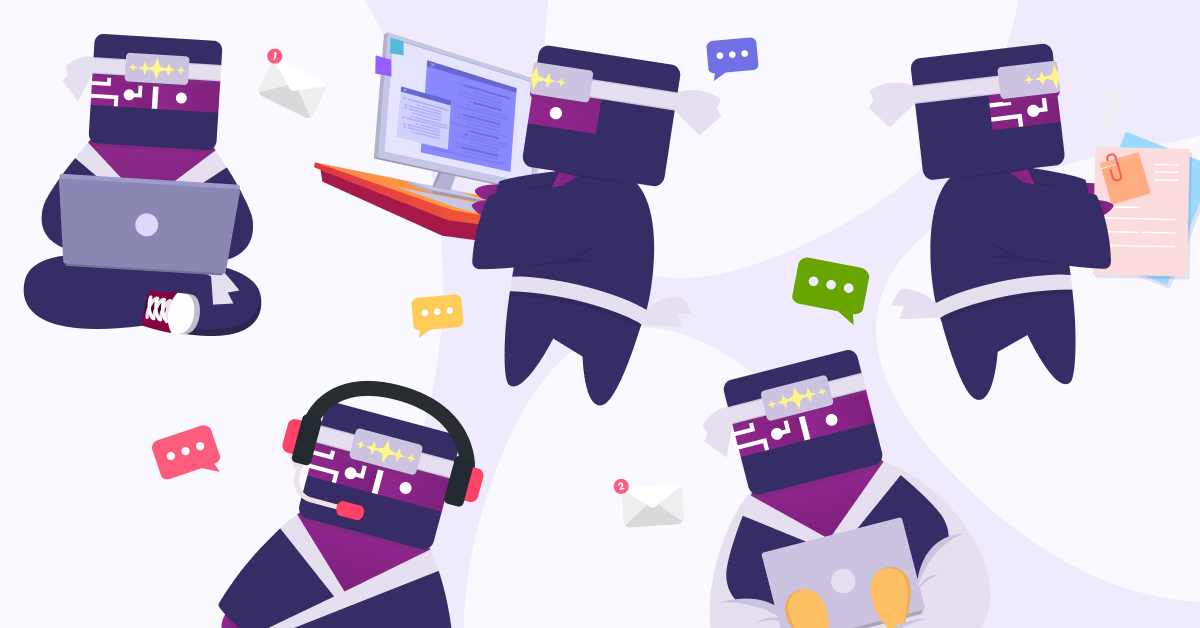Customer service software can make the difference between mediocre, good, and excellent customer experiences. When your service teams are mismanaged and disorganized it’s often a result of manual operational systems or using different software for every activity your company performs.
But deciding which tools are right for your business, choosing providers, and implementing a system is often an overwhelming task.
To help you narrow down your options, we’ll start with the basics of customer support software: what it is, the different types, and how it benefits your team. Then, we’ll wrap up with nine of the best CRM customer service software you should try in 2023.
- The ABCs of customer service software
- Categorizing customer service solutions
- Why customer service software is your key to success
- How do I know which software to choose?
- 9 best customer service software for 2023
- Choosing the right customer service software
The ABCs of customer service software
What is customer service software?
Simply put, customer service software is a tool to help you manage support and service requests from a single, central location.
More specifically, these tools will typically improve the data handling of customer support requests. It will help you collect, analyze, and report on customer queries more effectively and accurately. You can also choose to use customer service software to manage or integrate with communication channels, including email, text, chat, and social media.
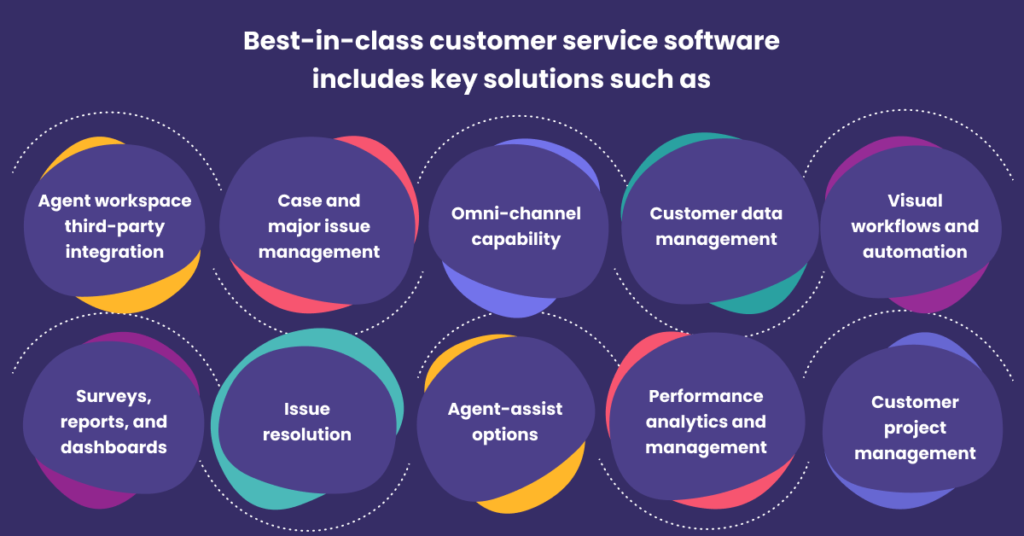
Best-in-class customer service software includes key solutions such as:
- Agent workspace third-party integration
- Case and major issue management
- Omni-channel capability
- Customer data management
- Visual workflows and automation
- Surveys, reports, and dashboards
- Issue resolution
- Agent-assist options
- Performance analytics and management
- Customer project management
An effective customer service software solution can help you improve the efficiency of your support agents, which leads to shorter customer-support response times. And customers who don’t have to wait long — are generally happier. And isn’t a happy customer the objective?
Categorizing customer service solutions
There are essentially five ways that the industry categorizes the software available for customer service. As we review each category, it’s important to consider three key factors: your strategic goals, your chronic needs, and the practical limitations that your business is currently under.
Considering the range of software capabilities — on one end of the spectrum there are basic services available that serve a single function while other software is designed to provide a suite of solutions at once.
It’s common for leaders to implement more than one of these solutions at once. However, according to our user testimonials, having an all-in-one software is ideal, if possible.
Single-function: messaging and chat tools
Messaging and Chat tools are great options if you do not require a full-featured help desk. These tools let you add a chat box to your website, thus offering your customers a way to contact an agent in real time. Despite its simplicity, Deloitte reports that in 2022, chat functionalities have enjoyed the largest sum of investment compared to other contact channels. Some systems offer chatbot options, while others put customers in touch with live support.
Single-function: shared inbox software
A shared inbox is a collaborative space where agents can access requests from a shared, centralized location. Multiple accounts can be collected into one inbox. It allows your team to collaborate and respond to inquiries, complaints, and questions.
Single-function: knowledge bases
A Knowledge Base allows your agents access to tips, tricks, and information in a searchable format to make it more accessible. Should your customer require a specific solution, your team can immediately provide them with the answers.
Typically, it’s offered in addition to tools like live chat or a help desk so that customers who can’t find the right answer on Google can reach out directly to get the answers from you.
Multi-function: Customer Relationship Management (CRM)
CRM platforms connect all the data from your sales leads and customers in one place.
Adopting CRM software is an industry-trusted strategy for success. According to HubSpot’s 2022 Annual State of Service Report, 95% of customer service leaders agree that a CRM platform is an effective way to increase productivity. It can record and analyze meetings, calls, and emails to help improve customer service, drive sales, and increase revenue.
It gives your agents access to a customer’s file to see their history, interactions, and other relevant information. A good CRM tool is vital if your business wants to track and improve customer interactions.
Multi-function: Service/Help Desk software
Help Desk Software helps organize, manage, and respond to service-related requests. It can be used for external requests from customers or internal service requests from team members.
Some help desks even incorporate different customer service solutions into one by including tools like a shared inbox, a knowledge base, and live chat options. Others integrate with third-party providers to offer CRM software to help with customer (and agent) management.
Help Desk software enables businesses to resolve customer grievances more efficiently by automating the complaint resolution process with a ticket management system.
Basically, it lets you streamline customer conversations to create a better customer experience and agent experience.
The best customer service solution for your business will be the one that helps your organization achieve its goals the most effectively. Finding the right fit for your business means you have to know the type of support experience you want your customers to have. Identifying their needs and aligning them with your objectives will help inform your choice.
Why customer service software is your key to success
No matter the company, or industry, an improved focus on customer support is always an advantage. Customer service software allows better support and improved customer experiences.
Gaining loyal customers
Customers are likely to repeat their business with you if you provide seamless, effective support. Achieving a customer base with unwavering brand loyalty is a huge indicator of business growth. One major insight gained in the 2022 Zendesk CX Trends report directly ties business gains to metrics like retention, satisfaction, and loyalty.
Better ROI
Though some might consider investing in customer service software costly, not investing in updated systems is a huge mistake. When workforce frustration comes down to clunky software and confusing operational procedures, it’s not only your employees that suffer, but your bottom line as well.
Increased efficiency
Dedicated support software features tailored to your business such as time management insights, knowledge base integration, CRM, and messaging tools are some of the biggest solutions driving businesses to adopt new software.
Automation is also a feature to look out for. It leverages machine learning so that teams can spend their energy solving complex customer inquiries.
Better customer insights
Identifying, collecting, and organizing feedback, feature requests, and bug reports lead to better customer insights. And when you understand your customers better, you can help them more effectively, which improves customer satisfaction rates.
Improved teamwork
Customer service is a collaborative activity. Agents need to always have access to their teammates and software can support that in many ways.
With customer service software, agents have access to all information, meaning you can reduce duplicated work. It lets you keep track of customer queries and coordinate multiple teams’ responses. This way, you can deliver up-to-date answers.
Better reporting
Customer service software collates all your data and provides you with reports on various services. It helps you to better understand changes in team productivity and customer behavior. From these insights, you can then create directed strategies for improving customer service, instead of getting lost in the numbers.
Highly skilled agents
Your team saves time, has access to all information, gets to work better together, and has the opportunity to improve their service. What’s not to love?
According to Zendesk, only 17% of agents are “extremely satisfied” with the level of training they receive. However, 78 % of senior leaders agree that service agents play a vital role in customer retention. Implementing the appropriate software can create an opportunity for your managers to integrate skills development into daily operations.
How do I know which software to choose?
We’ve provided you with a lot of information already but it’s time to personalize. Before you review the tools below let’s do a quick exercise.
This ‘Checklist for Success’ will give you an opportunity to think critically about the software available today.
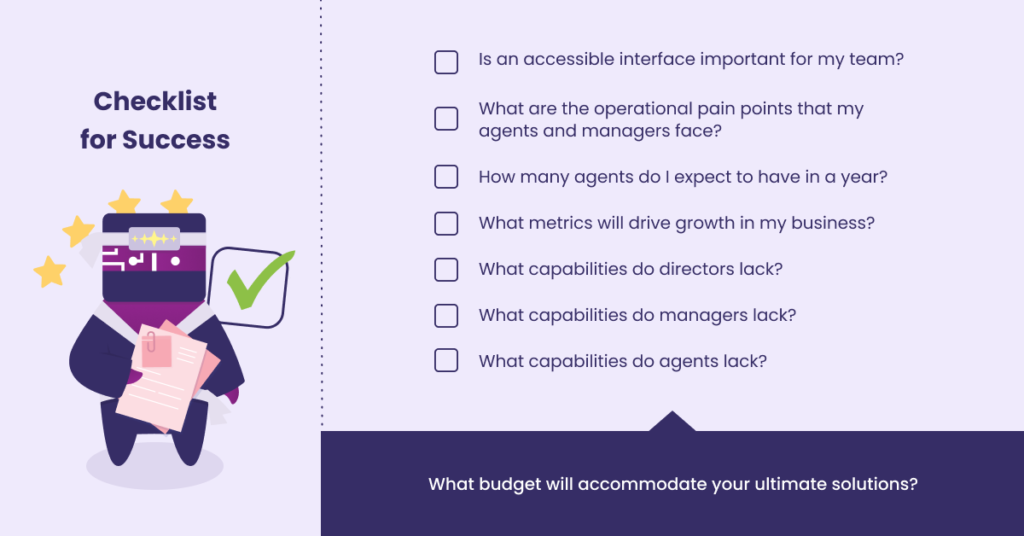
Sidenote: At the end of this article, we provide you with another checklist — This time for Software Evaluation
Best customer service software tools
1. Kaizo
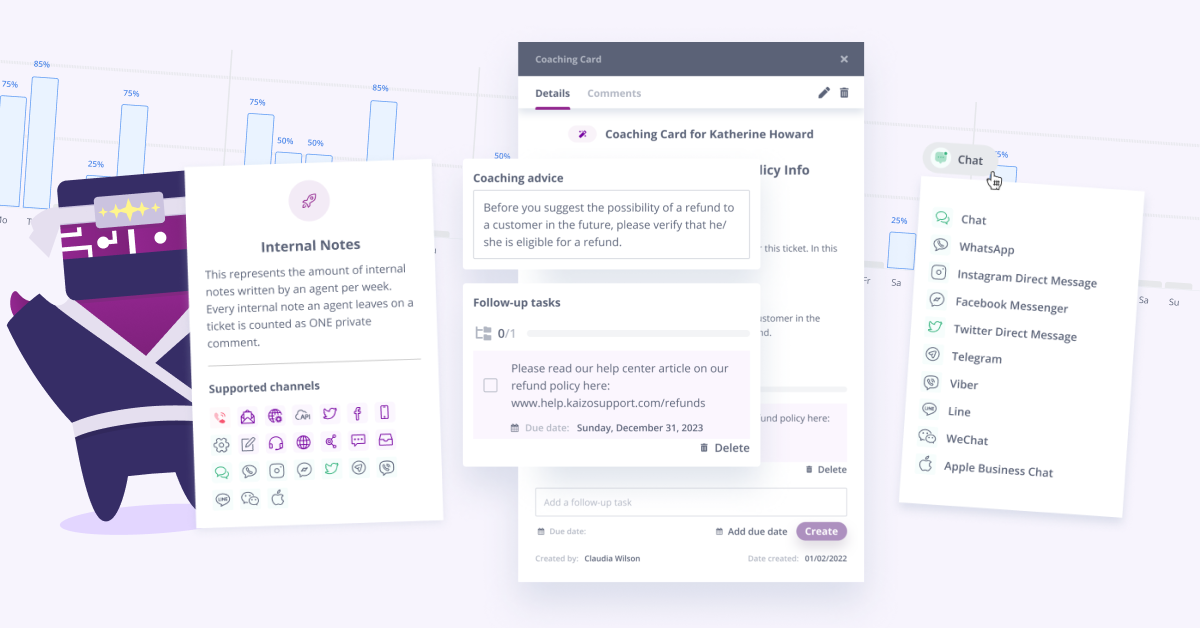
Kaizo offers its users a multi-functional software that leverages game theory to balance workforce management and agent skill-building.
This tool quickly turns performance intelligence into impactful coaching to set each team member up for success. Powered by AI, gamification, and an advanced QA solution — with Kaizo, users receive an actionable overview of team data and immediate opportunities to use it.
Kaizo’s Quality Assurance solutions are designed to align with how customer service really works. Grading quality assurance in real time is essential for delivering the optimal customer experience consistently and continuously.
Kaizo automates the collection and analysis of team performance and creates Alerts to indicate when an agent, team, or the entire customer service department reaches (or falls below) a quality threshold. With this feature, Kaizo allows managers to take immediate corrective action when it really matters; Thus, creating value for the agent and the company at the same time.
This platform is for business with the following goals:
1. Achieving personalizable, data-driven Quality Assurance
2. Establishing a link between excellent customer service and support agent motivation
3. Leveraging sophisticated metrics with automated data analytics
This platform is fully integrated into Zendesk and Salesforce, offering you an intuitive out-the-box solution. You just need to plug, play, and instantly access real-time data. With Kaizo, you can ditch the time-consuming spreadsheets and efficiently monitor, track, and guide team and individual performance.
2. Playvox
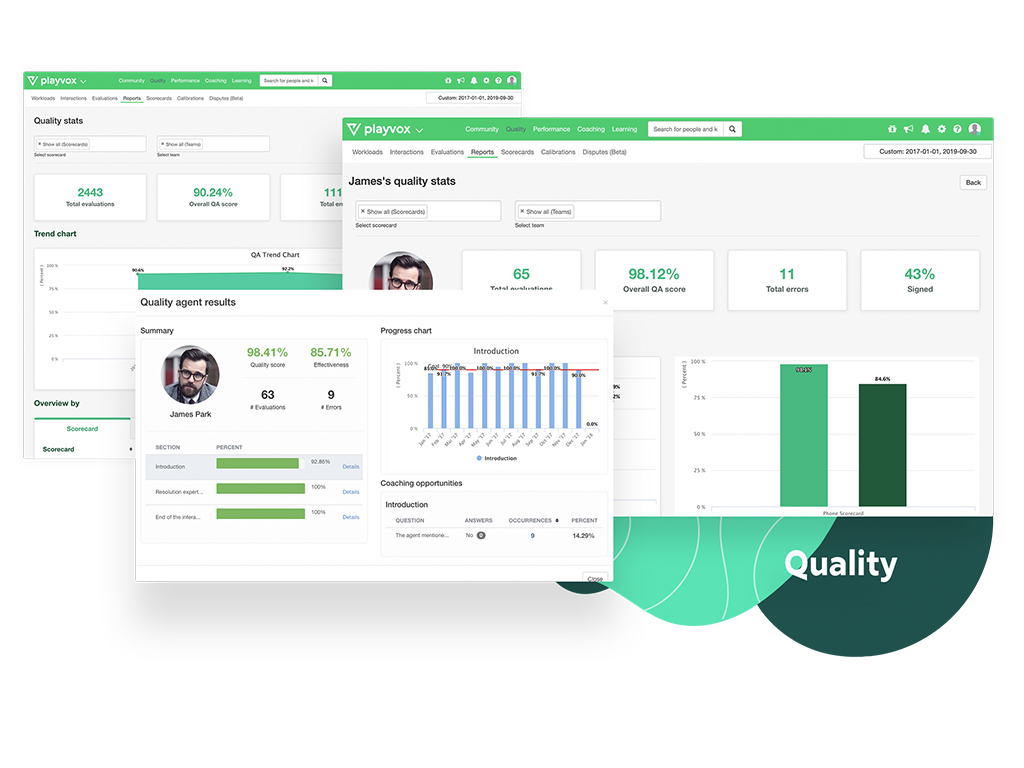
Playvox provides an automated & centralized agent management suite to help improve reports with real-time data from phone, chat, social media, and ticketing platforms.
Users like Playvox because the platform provides businesses with customizable KPI trackers. In addition, it provides insights into your team’s performance, including punctuality, adherence, occupancy, service levels, workstreams/queues, schedule tasks, and forecasts. They also provide quality assurance programs to assess agent performance during customer interactions to gather insights.
With Playvox you can avoid over-scheduling to reduce costs and under-scheduling to maintain customer service levels. It allows you to create and track custom KPIs to combine with standard customer service KPIs for a holistic view of your team’s performance. Improve call handling, behaviors, compliance, and soft skills.
3. Pathlight
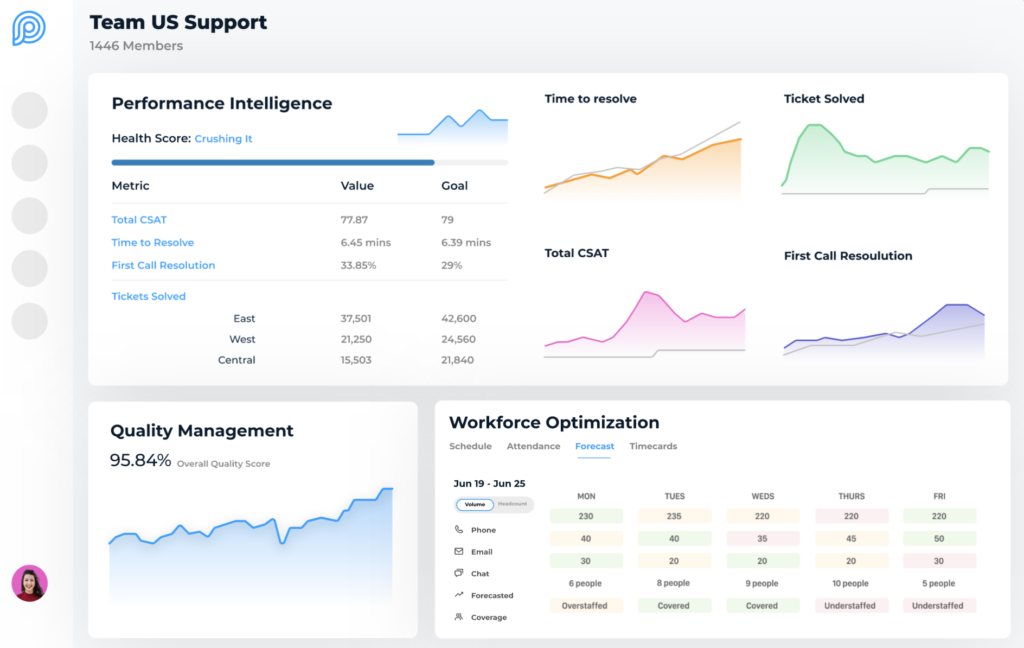
Pathlight provides a Real-time Performance Management (RPM) platform to allow customer-facing teams to manage performance faster. It will help you analyze goals against historical trends to visualize and benchmark performance.
With automatic documentation, group metric assignments, and automated agendas, you can give leadership complete visibility about the organization. Pathlight integrates with platforms like Zendesk, StellaConnect, Lessonly, Snowflake, and Five9 and provides real-time dashboards and streamlined QA functionality and transparency.
By consolidating performance data, QA, coaching, and communication in one place, the platform empowers data-driven management at every layer of the organizational chart.
An interesting feature that Pathlight’s users enjoy is the ability to take work on the road! With their field service option, Pathlight has translated their product into an application for smartphones.
4. Tymeshift
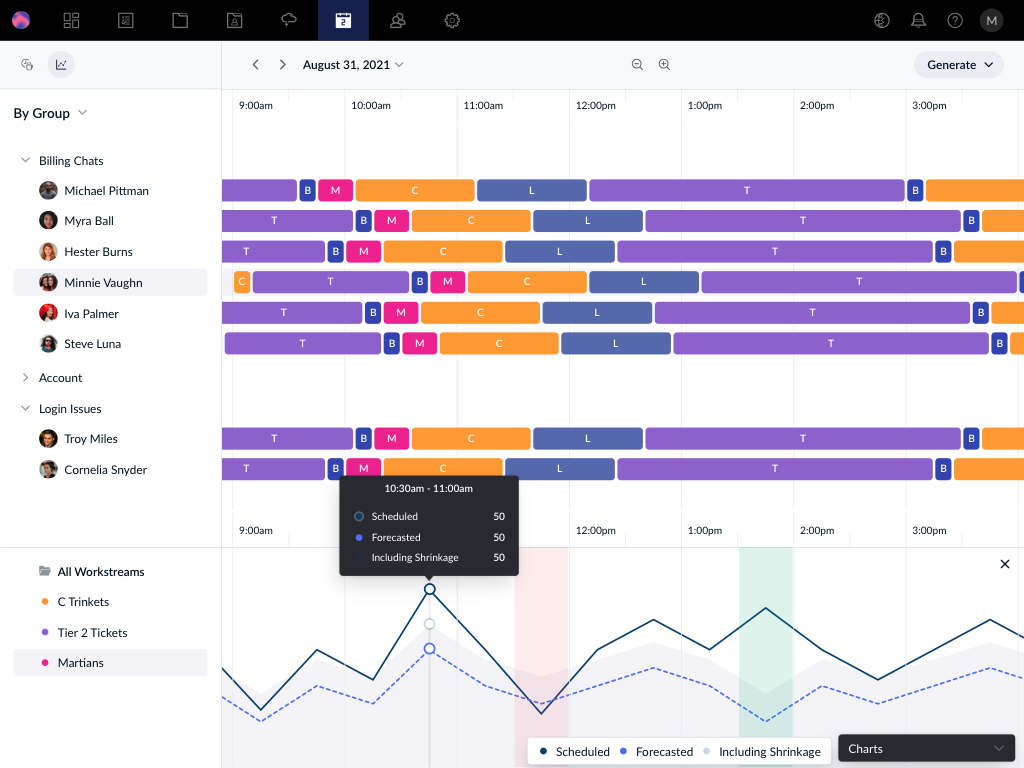
Tymeshift‘s primary functionality is focused on time management solutions.
As a software built to accomplish managerial responsibilities, Tymeshift presents an opportunity for its users to balance their workflow appropriately. It provides automatized schedules that include lunch, breaks, and the specific support work agents need to focus on throughout the day. As a bonus point, this platform can help you improve forecasting and analytics by using all your company’s pre-existing call volume data.
With real-time monitoring of schedule adherence to tracking unproductive times and time off, Tymeshift provides managers the transparency they need and the tools to help empower agents. Because providing your agents with detailed schedules can help them focus on one task at a time to deliver a better, more focused customer experience.
5. SupportLogic
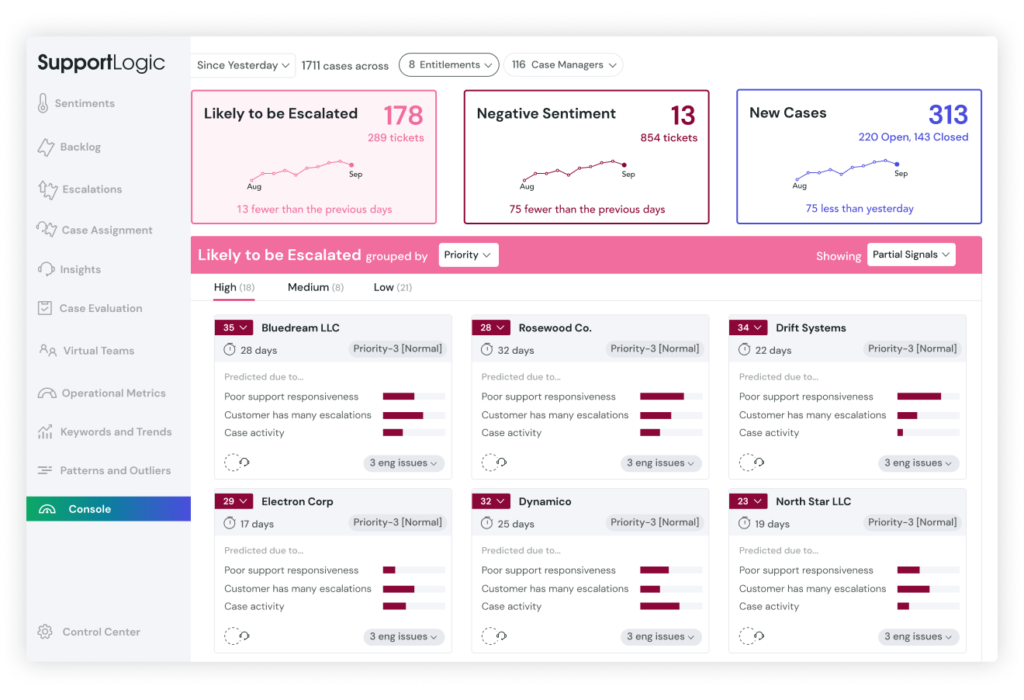
SupportLogic helps teams evolve from reactive to proactive service delivery.
Unlocking insights from unstructured data in your ticketing systems, it tracks customer sentiment in real time without surveys across multiple service channels. You can monitor cases and easily spot those that need urgent attention to fix problems before it’s too late.
With AI and NLP technology, you can gain insights into predicting and preventing escalations, improving CSAT & NPS, and reducing churn.
With SupportLogic, managers receive recommendations and intelligent collaborative workflows so service and support teams can take action to improve the customer experience.
6. Centrical
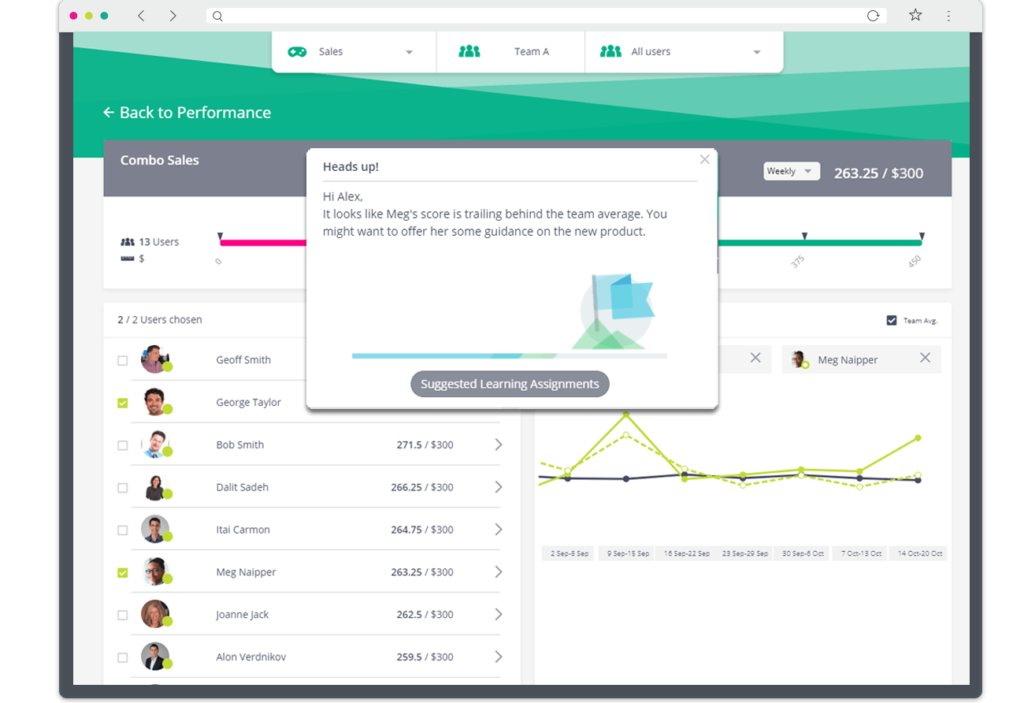
Centrical is for companies with their eye set on one goal: numbers, numbers, numbers.
This software solution uses real-time employee performance data to help managers set goals tied to real-time performance data on anything from sales milestones to learning completion or performance KPIs. It keeps the goals relevant with automated updates based on actual performance, employee characteristics, or business objectives.
Each employee’s personal dashboard shows them how they’re doing in real-time. Centrical creates prompts, training, and updates from their dashboard, telling them exactly what they need to focus on to improve their productivity and performance.
The purpose of this dashboard feature is to give agents access to the bigger picture. As they compare their activity to their company’s strategic objectives, agents can see how their work activities connect to performance goals, not only for themselves but the business at large.
7. Medallia (formerly Stella Connect)
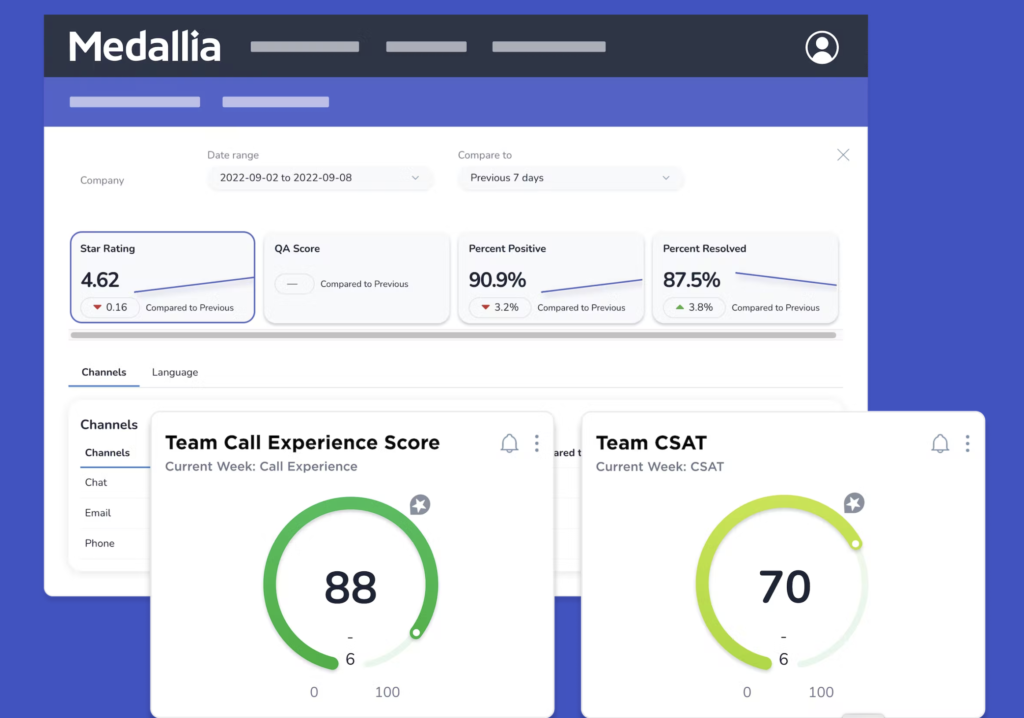
Medallia can provide solutions for businesses that value customer opinion.
Once Stella Connect, this platform is built for customer experience teams. Medallia is a complex software that offers many solutions for today’s digital business interests. One feature that makes this platform interesting to users is its digital listening capabilities. Medallia uses its access to personal data to grab an overview of how customers are talking about their user’s products.
Medallia provides a platform for the new-normal. It utlizes mobile access to keep work-from-anywhere teams connected through role-specific dashboards, transparent feedback, and personalized coaching. Another speciality feature included in Medallia is their attention to support service locationalization.
Location-specific customer feedback location is pushed to the relevant team members so they can follow up with the reviewer personally. Using Medallia’s mobile app, managers can address the complaint sooner than ever. Thus, defescalating potential problems before the risk garners attention.
8. Verint Monet
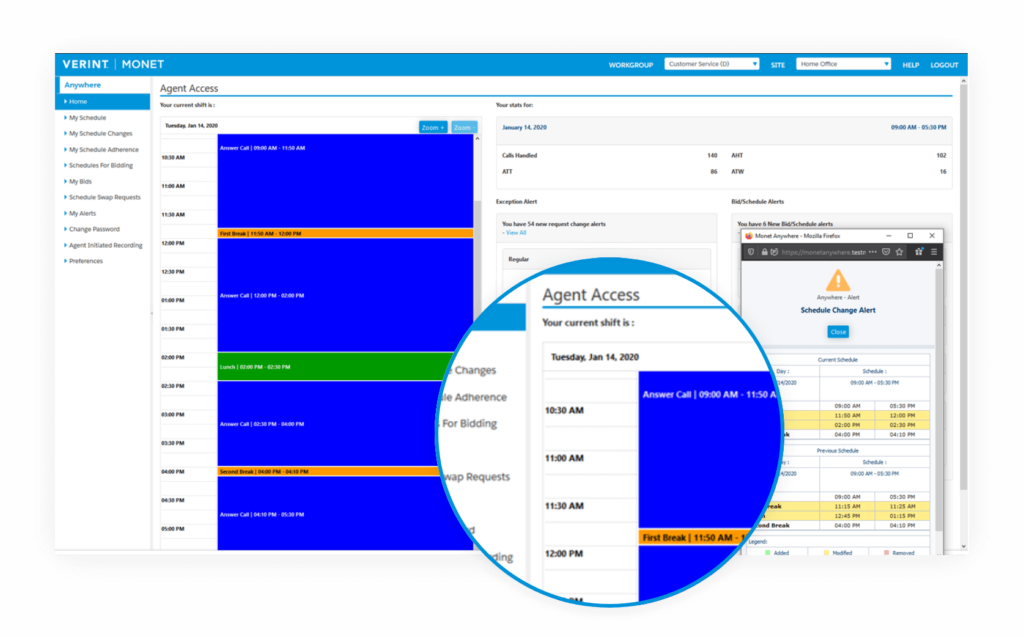
Verint Monet is a cloud-based workforce engagement solution for small and medium-sized businesses.
This platform includes workforce management, quality monitoring, performance management and analytics in one. It enables you to align your people, processes, and systems to your goals and objectives, such as customer satisfaction and experience, cost control, and revenue generation.
It helps you to transform contact center management to a proactive approach. Using scorecards, KPIs, real-time alerts, agent analytics, and customizable reports, it delivers the insights needed so you can take corrective action. It automatically collects and presents real-time and historical performance data freeing up time for managers to focus on working with agents.
9. Klaus
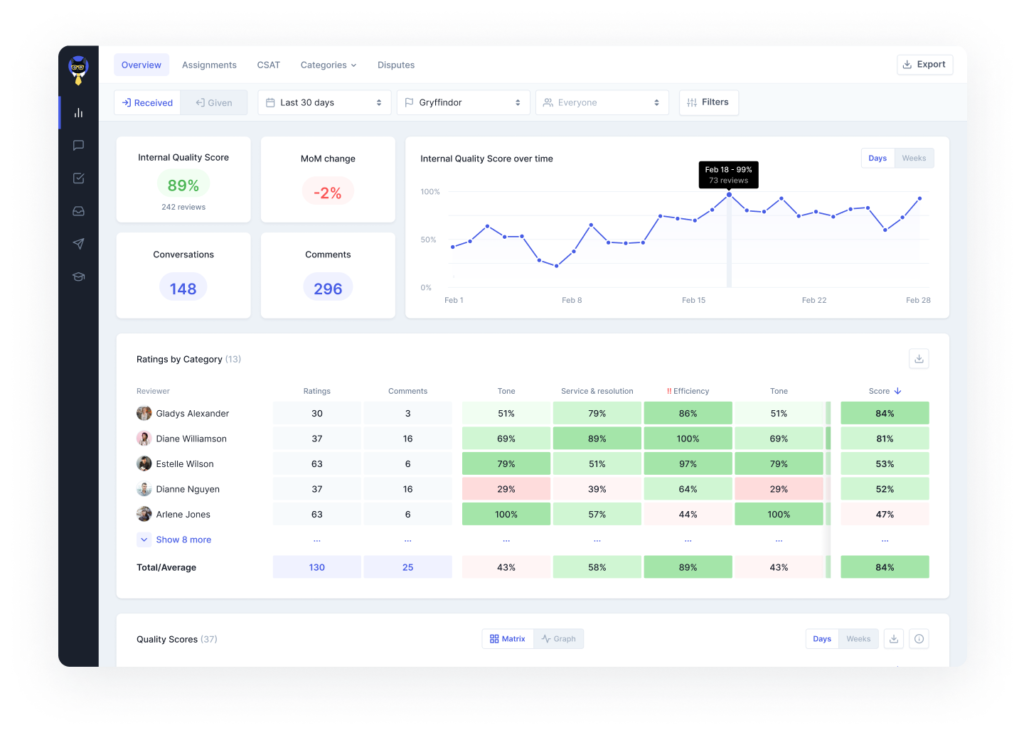
Klaus is software for Quality Assurance that provides a clear oversight of customer impressions and performance data.
Businesses that work with Klaus have access to a tool that assists in recognizing trends in performance at the agent, team, or departmental level. With an emphasis on producing consistent and uniform teams, managers can ensure their agents are all on the same page.
Klaus creates a space for managers to build Scorecards and review agent touchpoints to ensure consistent service delivery. With easy-to-navigate rating systems, Klaus helps agents see where an interaction went wrong. With the Conversation Insights functionality, they can further investigate QA trends across teams by filtering conversations for positive or negative sentiment.
Choosing the right customer service software
Finding the best solution for your business starts with identifying customer needs and goals, and aligning those goals with your own objectives.
So, where do you start?
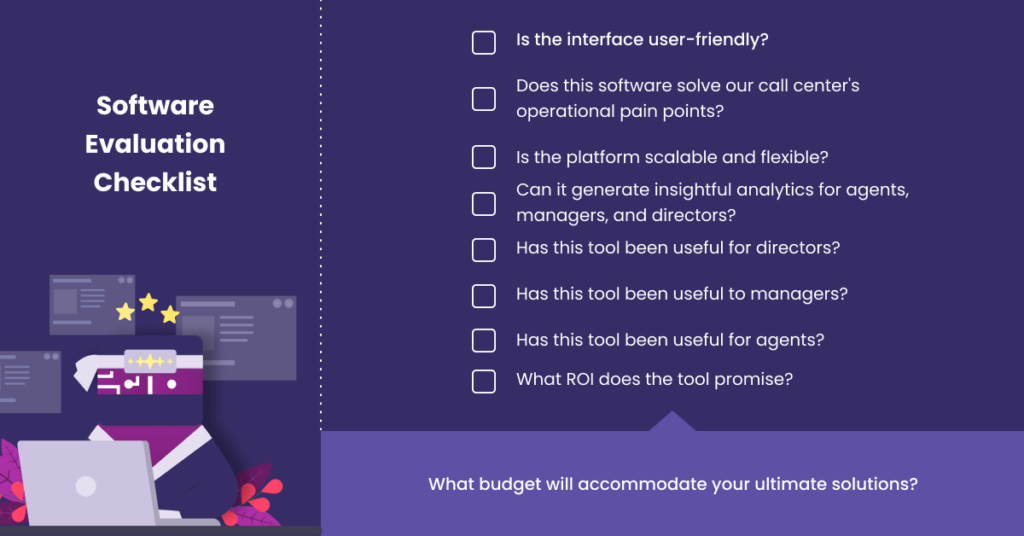
Consider your budget
Some customer service software may be free, so budget won’t be an issue, but others can run costly. Though, we have already pointed out that there is a significant ROI, it doesn’t mean you can toss the account book out the window. Your employee resources such as the number of agents, may influence your decision and limit your options when it comes time to choose the right customer service platform for your business.
Define your needs
Different tools offer different capabilities. So, decide which is most important for you. If you have scheduling conflicts, issues with QA, need better training, monitoring, coaching or reporting, automating interactions, etc. Whichever you decide, the main focus needs to be improving support for your customers, and improving the performance of your team.
Consider the issues that you are currently facing, all impediments to improved performance, and decide on the platform that will solve most of your problems. It will provide you with a clear idea of how you want your customer service software to perform.
Research the options
Once you have a list of the tools and features your ideal customer service software solution needs to have, it’s time to dive into the rabbit hole. Consider everything from user reviews and recommendations, to comparisons. You can even take a look to see which platforms your competitors are using. Once you’ve narrowed down the options, it’s time to…
Take advantage of demos and trials
All platforms will either provide you with a demo, a free trial or both. So with your list of top candidates — it’s time to go directly to the source.
We may be biased, but why not start now?
